Introduction
Selecting the right Education Content Management System (CMS) for your institution is a critical decision in the current digital landscape.
As universities adapt to the "new normal" of a digital-first era, the impact of COVID-19 on higher education has been unprecedented, leading to uncertainties about the upcoming semesters globally.
In response to this digital paradigm shift, leaders in higher education are proactively preparing for the future.
“Not everybody's going to survive, for people who are forward-thinking, fast-pivoting, opportunistic visionaries, this is a really exciting time to be in higher ed. But it's also quite scary because 20% of colleges aren't going to make it.”
- Dr. Nancy Hubbard, University of Lynchburg
The central question arises: What is the most crucial aspect to get right in this digital evolution? The answer is your website. Serving as the online identity of your institution, the website is the platform that attracts, engages, and delights prospective students, shaping their seamless experience.
Outdated and lackluster education websites have a direct impact on the reputation of universities among prospective students, parents, and potential hires. This, in turn, affects enrollment rates, potentially leading to a significant loss of revenue, estimated at up to $19 billion collectively.
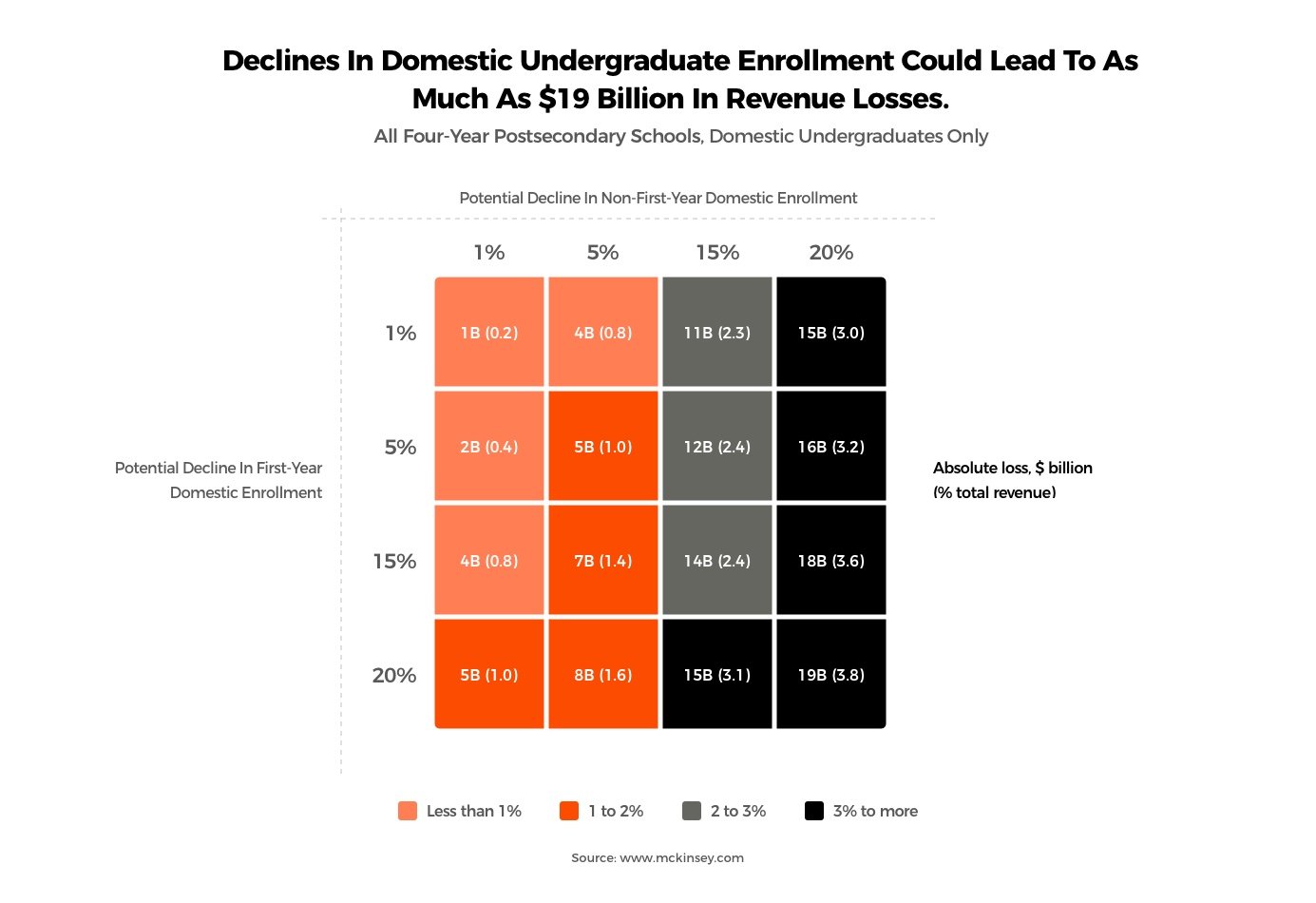
Achieving a seamless online experience hinges on the choice of an integrable School Content Management System (CMS). In higher education, these CMSs go beyond supporting digital marketing or communications; they serve as central tools for staff, faculty, students, and others. Modern login portals must surpass the functionality of past systems like "angel systems" or "blackboard systems."
Choosing the right Content Management System for Higher Education can be daunting, given the myriad tasks prospects want to perform.
NYC Design research on 3,360 higher ed websites, including prestigious institutions like Stanford University, University of British Columbia, UC Berkeley, University of Michigan, and Cornell University, reveals that 90% of these sites are built using twelve education Content Management Systems.
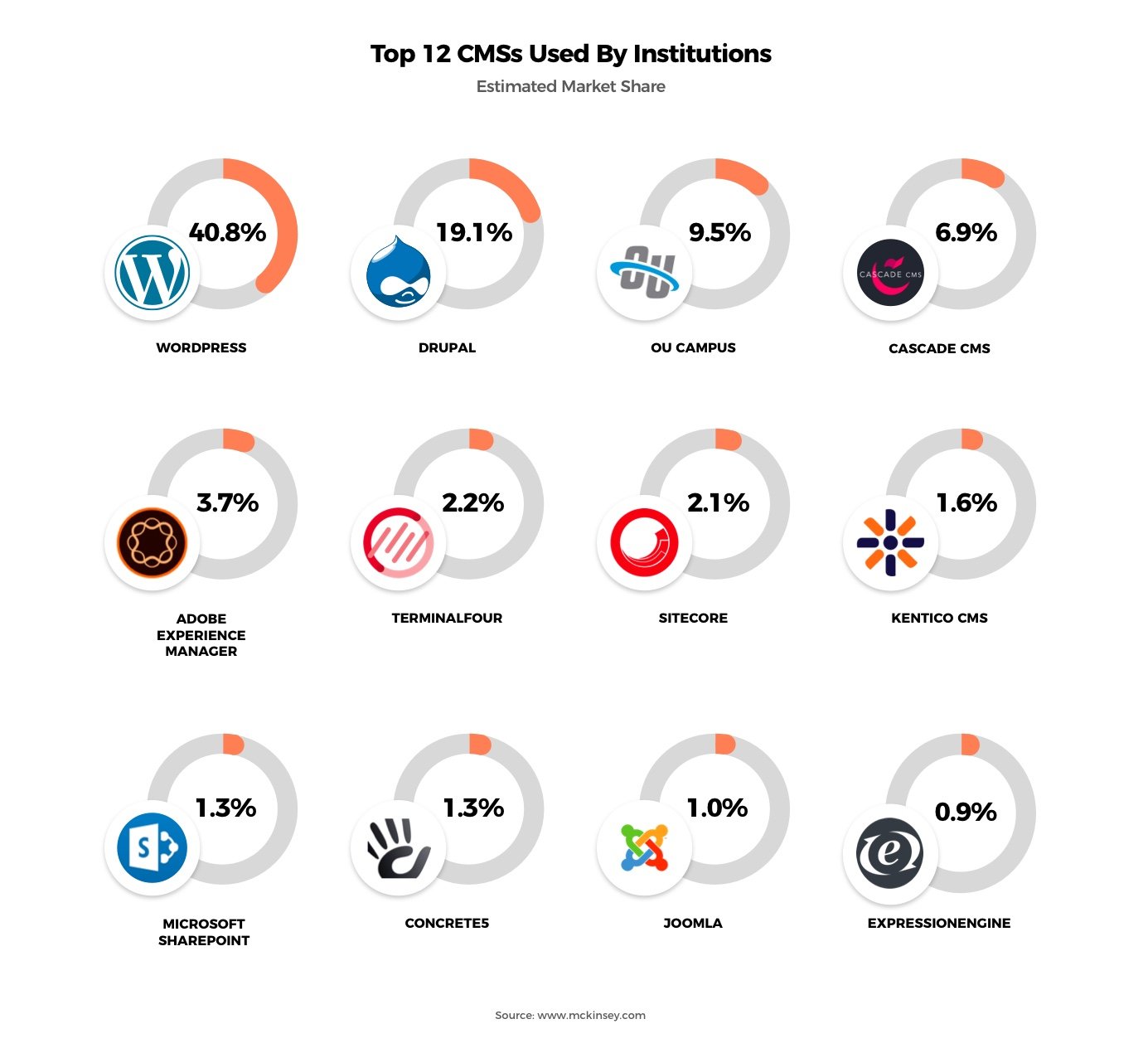
Among these CMSs, WordPress and Drupal emerge as leaders, capturing 40.8% and 19.1% shares, respectively, as of 2023. The choice between WordPress and Drupal depends on the institution's type and specific needs. While WordPress is popular for its user-friendly interface and affordability, Drupal dominates among larger, more premium universities with complex requirements.
For instance, the top five US universities, including Harvard University, Stanford University, Massachusetts Institute of Technology (MIT), University of California, Berkeley (UCB), and the University of California, Los Angeles, have chosen Drupal development services as their Higher Ed CMS. This preference reinforces Drupal's status as the preferred CMS for larger institutions seeking a robust platform to meet their diverse and complex needs.
Princeton, Stanford, University of East London, University of Dundee — the world’s top schools build better .edu sites and create great digital experiences with Drupal. Today, Drupal is the most widely used content management system in higher education, with 71% of the top 100 universities relying on the open source content management system to drive their digital strategy.
Should I Choose an Open Source Education Content Management System in 2024?
Do you wish to control the destiny of your website and deliver an orchestrated experience to your students and faculty? As quoted by Linus Torvalds:
“In real Open Source, you have the right to control your own destiny.”
Controlling the destiny of your institution's website and delivering an orchestrated experience to students and faculty is a crucial decision, echoing the words of Linus Torvalds: "In real open source, you have the right to control your own destiny." With approximately 60% of university websites built on an open-source Higher Ed CMS, opting for this approach becomes the optimal choice for higher-ed tech leaders in shaping their university or college platform.
An open-source education content management system seamlessly ties together services, data, and content across any tech stack. This integration facilitates the delivery of orchestrated digital experiences across channels in an agile manner, leading to a transformation that enhances the flexibility and resilience of institutions in the long term.
What Is An Open Source Education Content Management System?
An open-source website employs open-source software (OSS), allowing anyone to inspect, modify, and enhance the source code. Notably, Drupal stands out as one of the most popular open-source content management systems for higher education institutions. Marketers, developers, and CxOs in higher education can effortlessly connect with open-source community groups globally, engaging in platforms such as Drupal camps and conferences, where IT professionals from academic institutions actively contribute.
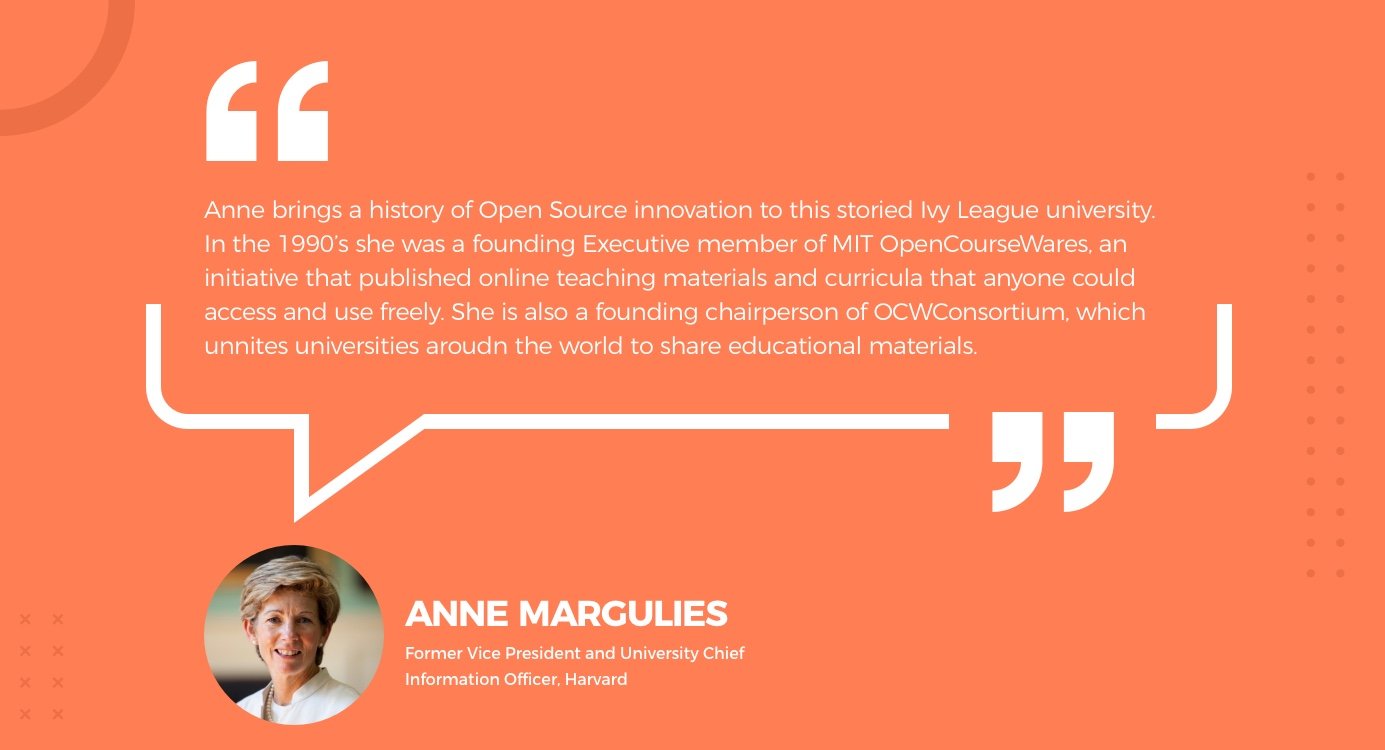
Reasons To Use An Open Source Education CMS
In a fast-paced digital landscape marked by technological growth and transformation, the success of a digital strategy hinges on agility, scalability, accountability, and flexibility. While proprietary technology has its benefits, the guarded secrecy of its source code contrasts with the transparency essential in education. Open-source Content Management System for Higher Education emerges as a superior option for university websites.
Key reasons for universities to embrace Open Source Education Content Management Systems include:
- Large Developer Communities: Tap into collaborative knowledge and support from a vast community.
- Widely Adopted: Open Source CMSs like Drupal are widely embraced in the education sector.
- Ease in Academic Publishing: Facilitate seamless academic content publication and management.
- High Security: Prioritize security, a critical aspect for educational institutions.
- Affordability: Open Source solutions offer cost-effective alternatives to proprietary technologies.
| There are a considerable number of Open Source education Content Management Systems available in the market. Which one should you choose, and what factors should you consider while selecting the right higher ed Content Management System? This CMS Evaluation Framework may help you to make an informed decision. |
Reasons To Choose Drupal as Your Higher Ed Content Management System
Amid the impact of COVID-19 on students' willingness to enroll, it is imperative to revolutionize the student experience, affirm their decisions, and provide a personalized engagement journey from enrollment to graduation. Campus activities, including tours, living arrangements, and dorm life, remain uncertain, leading to a significant decline in campus visit requests.
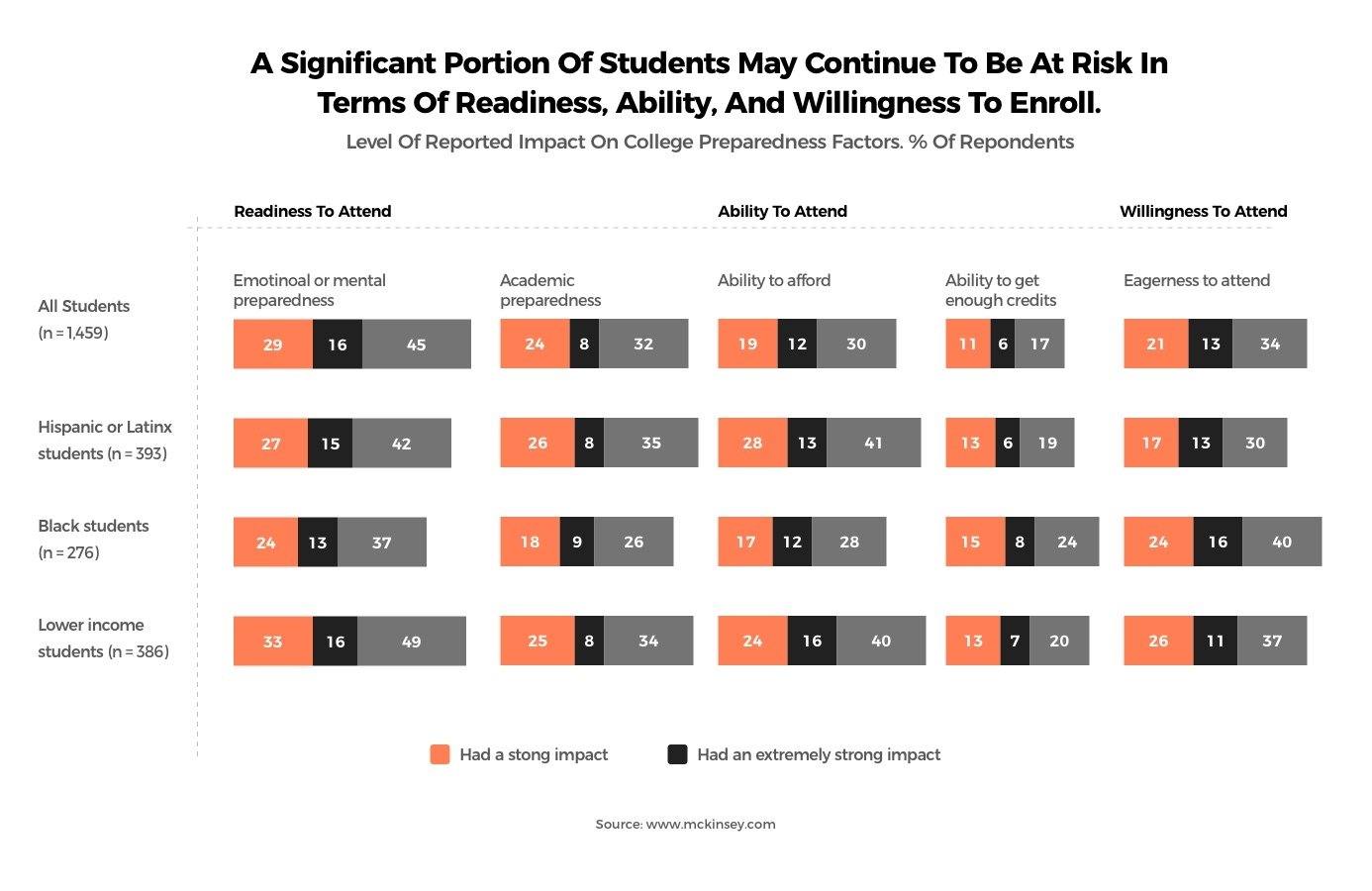
|
We have to keep in mind that campus tours, campus living, dorm life, etc. are still uncertain in the coming semester. 36% of institutions are experiencing a steep decline in campus visit requests and the number of campus tours are further expected to drop. Just like businesses offering work-from-home or flexible arrangements, it’s likely institutions of higher ed will have to do this in light of any negative C19 developments (of which, delta is one.) |
In this era where students may interact more with.edu than their physical classrooms, the importance of the institution's website has surged. A powerful and flexible open-source school content management system is the answer, with Drupal standing out as the choice for 70% of the top higher education institutions' websites.
Drupal's adaptability and flexibility position it as a reliable CMS for higher ed, aligning seamlessly with the evolving needs of higher education in 2023.
1. Marketing
To overview how a student's journey on a university website begins when they search to enroll in an online program:
- They start online research for their desired program
- They shortlist a few university websites
- They complete filling the first application form
2/3rd of students often complete step (c) within just four weeks of starting online research. It implies that universities have four weeks to move at par with the prospective student's decision-making speed and offer them a personalized experience to engage.
And here, marketing offerings, at speed and scale, in a personalized manner play an important role. Thus, big higher ed players spend on marketing heavily to increase the online enrollment rate, which is evident from the following analysis.
The CMO Survey conducted by Duke University highlights that amongst the 15 industry sectors, the use of Digital Marketing, with a mean degree of 6.20, has contributed the most in the education sector. Unsurprisingly, the more a university spends on marketing initiatives, the higher is the enrollment rate.
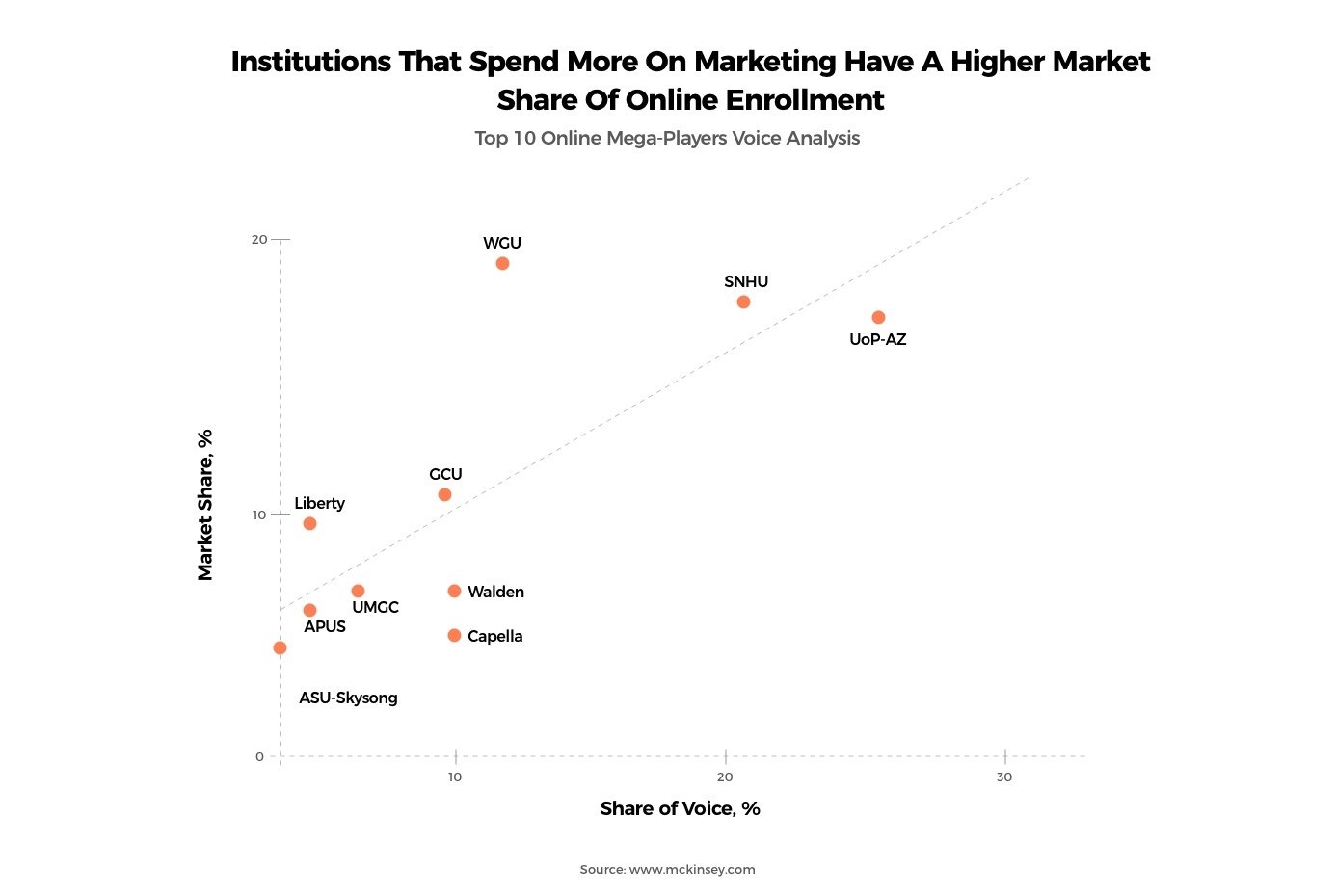
The Digital Marketing ecosystem includes all the digital channels an institution uses to communicate with its prospective students, nurture them till they are ready to enroll, convert them and promote new enrolments from actual students.
To make their Digital Marketing initiatives a success, higher ed marketers do need data about geolocation, prospect demographics, and previous history. However, they also need data about what their prospective students are doing and looking for right now.
Unfortunately, in most institutions, this type of data resides in silos and the technology that could orchestrate this prospect journey is not connected effectively to the martech stack.
“There is a lot of data out there, the key is to learn how to leverage that data to provide the best experience for your prospective audience.”
- Luci Geraci, Executive Director, Web & Digital Marketing, Council on International Educational Exchange
Drupal is a powerful answer to this challenge. Being an Open Source education content management system, Drupal is easily integrable with existing systems using open APIs that allow student data to flow seamlessly throughout the institution. Also, Drupal-based digital properties allow higher ed marketers to collect key prospect data that help them to design a comprehensive view of prospects.
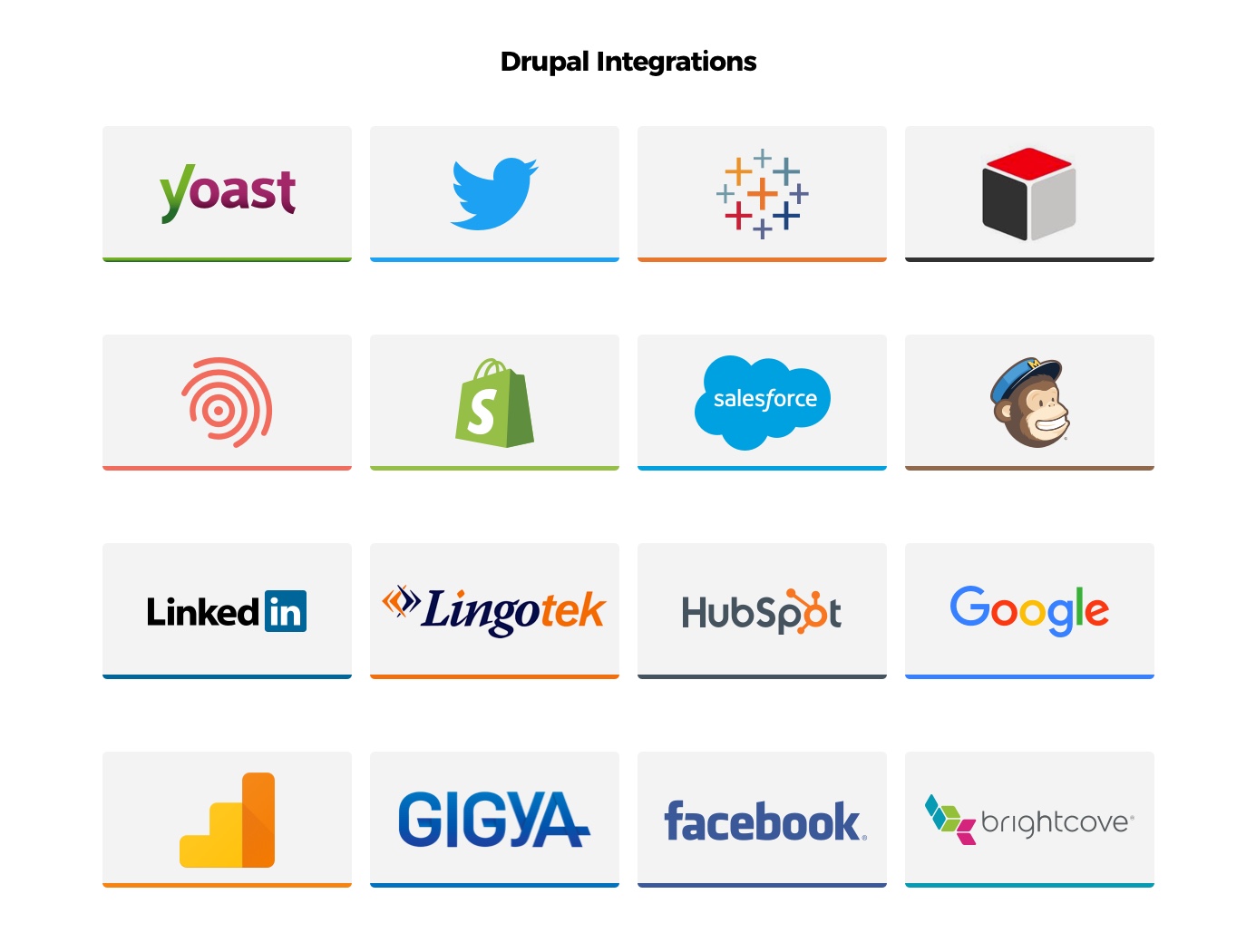
With Drupal marketing, higher ed markets can:
- Get a 360-degree view of prospects
- Streamline campaign management
- Connect systems and data sources with open APIs
- Build memorable experiences across platforms with multi-channel reach
- Deliver global experiences in any language, with multilingual functionality
As a robust Higher Ed Content Management solution, Drupal is behind many of the digital experiences that are part of the marketing efforts of leading universities. There are several Drupal marketing modules created by the Drupal community that can be used with Drupal sites to help with marketing initiatives. Some of the top Drupal Digital Marketing modules are as follows:
- Webform: It is an essential building block that integrates Drupal and other third-party marketing automation software.
MicroAssist Inc., an Austin-based technology training and consulting company, relaunched its website on Drupal and added a Webform module to their website. Their marketing time was super-excited with the ability of Webform to quickly and effectively build different types of forms.
- Mautic: Mautic allows for multi-channel communications and campaign management, content customization, email marketing, visitor tracking, and personalization, to name a few.
Mautic is an Open Source marketing automation platform acquired by Acquia. The community version of Mautic lacked the ready-to-use plugins required by the Acquia marketing team. They collaborated with Axelerant to develop Mautic plugins to extend functionality.
- Google Analytics: The Google Analytics Drupal module allows marketers to add a web statistics tracking system to the website. It helps track and monitor search systems, Adsense, custom code snippets, and much more.
- HubSpot: The HubSpot Drupal module integrates seamlessly with Webform and the HubSpot API. The entered information of a user on Drupal Webform is sent to HubSpot’s lead management tool, which is further tracked and nurtured.
- Search API Solr: The Search API Solr Drupal module helps configure Solr search on a Drupal website. It works in collaboration with the Search API module, for which it provides an Apache Solr backend.
2. Accessibility
Education should be available to all, irrespective of caste, creed, gender, or native language. But the challenge is how to make it fully accessible - 71% of users with a disability leave a website that is not accessible to them.
“So if a college education is indispensable, the challenge as I see it is how to make it more accessible.”
- Gordon Gee
In 2016, a visually impaired student's lawsuit against Miami University underscored the critical importance of web accessibility. The university, faced with inaccessible websites, had to pay $25,000 in compensation and overhaul its web content to meet federal accessibility standards. Such incidents highlight the ethical responsibility of universities to ensure equal access to educational resources.
The exploration of ethical practices by students during the university selection process reveals a growing awareness of accessibility issues. Lawsuits against universities failing in this regard indicate a need for institutions to prioritize ethical responsibilities.
However, auditing websites for accessibility is a complex and resource-intensive task. Scott Lissner, Americans With Disabilities Act compliance officer at Ohio State University, humorously captures the enormity of the challenge, stating that the number of webpages at Ohio State is "somewhere between five and eight million, depending on what definition you're using and what moment in time it is."
Enter Drupal, a comprehensive education content management system (CMS) designed to meet the demands of the digital ecosystem while adhering to accessibility standards. Drupal's commitment to accessibility is evident through features designed to enhance user experiences for people with disabilities:
- Accessible inline forms:
- Challenge: Visually impaired users may struggle with error notifications on form submissions.
- Solution: Drupal introduced the Inline Form Errors module, aiding visually impaired users in identifying errors by providing alternative formats for error notifications.
- Anyone can easily add alt text and tags:
- Challenge: Embedded images on websites may lack accessibility for visually impaired audiences.
- Solution: Drupal mandates alt text (alternative text) for images, ensuring that meaningful descriptions accompany images, making them accessible to all users.
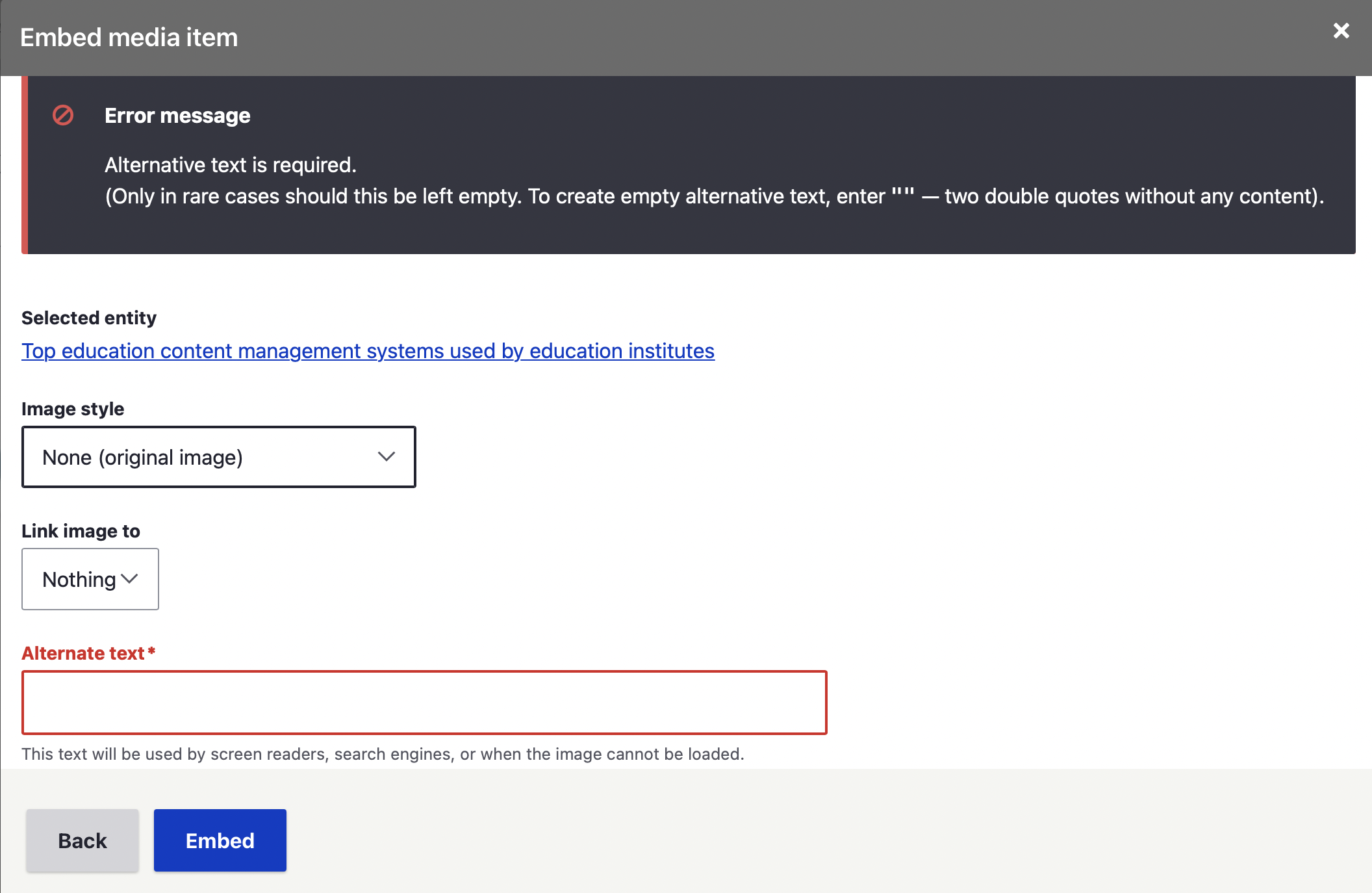
- Seamless management of tabs:
- Challenge: Non-visual and non-mouse users face difficulties navigating webpage elements.
- Solution: Drupal's TabbingManager, a JavaScript feature, allows logical access to critical page elements. Higher ed marketers can precisely control the tabbing sequence, enhancing the experience for users who rely on keyboard navigation.
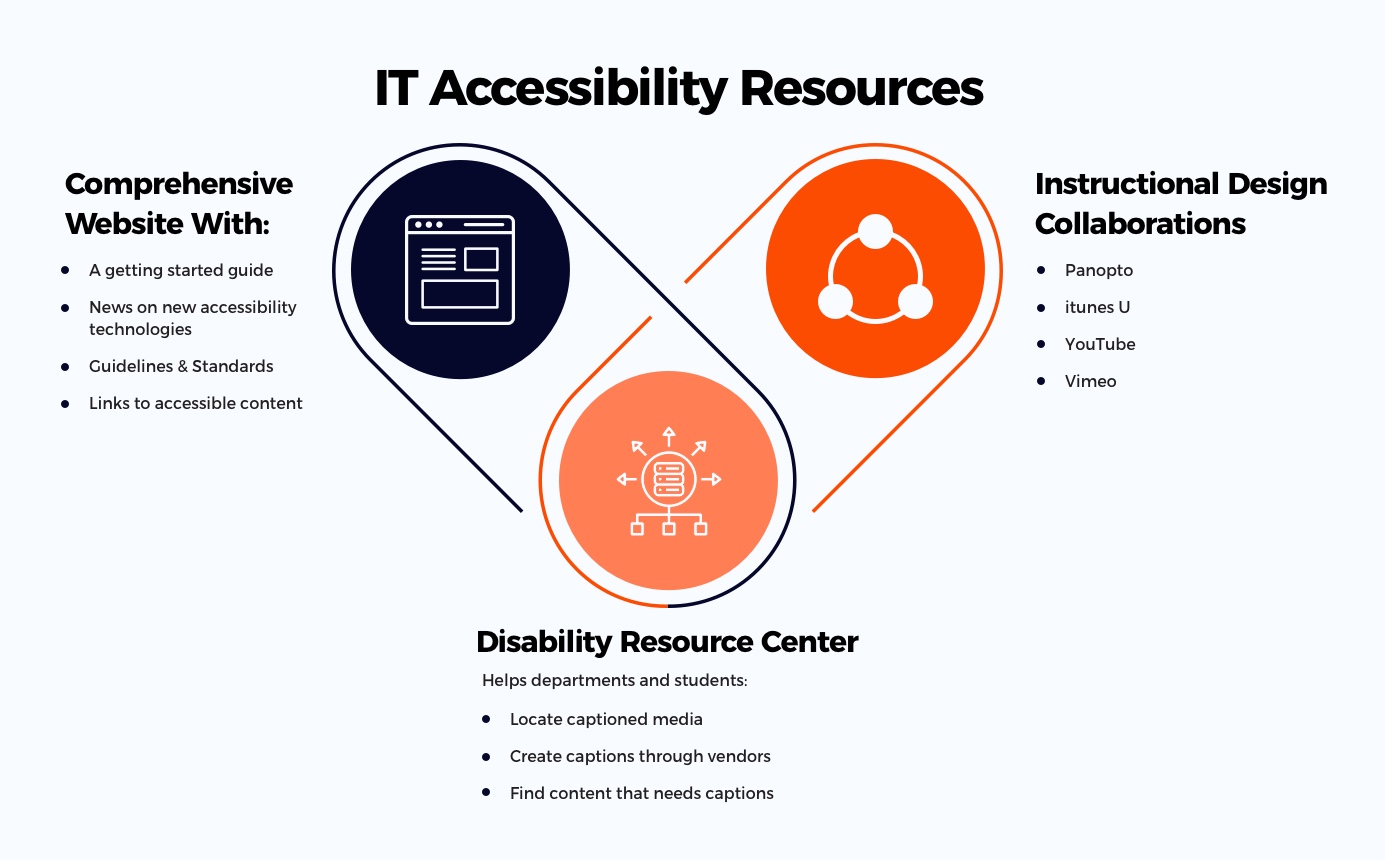
In essence, Drupal not only acknowledges the significance of accessibility but actively integrates features that contribute to a more inclusive digital environment. By choosing Drupal as the CMS for higher ed, education institutions align themselves with a commitment to providing accessible and equitable educational opportunities for all
3. Personalization
In the digital age, students expect a personalized online experience akin to that of industry giants like Amazon and Netflix—seamless, orchestrated, relevant, and immediate. Recognizing this, 70% of higher education leaders consider digital engagement and websites as paramount marketing tools to attract, engage, and convert prospective students.
A student-centric engagement platform strives to deliver a highly personalized experience both before and after enrollment. For instance, Arizona State University (ASU) and Southern New Hampshire University (SNHU) leverage predictive analytics to identify academically struggling students and provide timely interventions. These personalized experiences foster lasting engagement among modern learners.
Drupal has adeptly seized this opportunity to provide 360-degree digital experiences that are not only relevant and immediate but also personalized. Leveraging browser history, geolocation, behavior taxonomies, and device type, Drupal enables users to capture user interactions at every touchpoint. This information allows for the curation of a comprehensive vision of personalized offerings, ultimately enhancing retention and online enrollment rates.
An exemplary instance is the Stanford University website, which harnesses Drupal to empower campus members to effortlessly design, build, grow, and manage brand-standard sites. These sites are tailored to individual needs, all while prioritizing security.
Read more to learn about personalizing student experiences in higher education.
4. Security
Security is a paramount concern for higher education decision-makers, given the frequent targeting of college websites. In this context, the choice of a digital platform becomes crucial. Open source software (OSS) is generally considered more secure than proprietary software, and Drupal stands out in this regard.
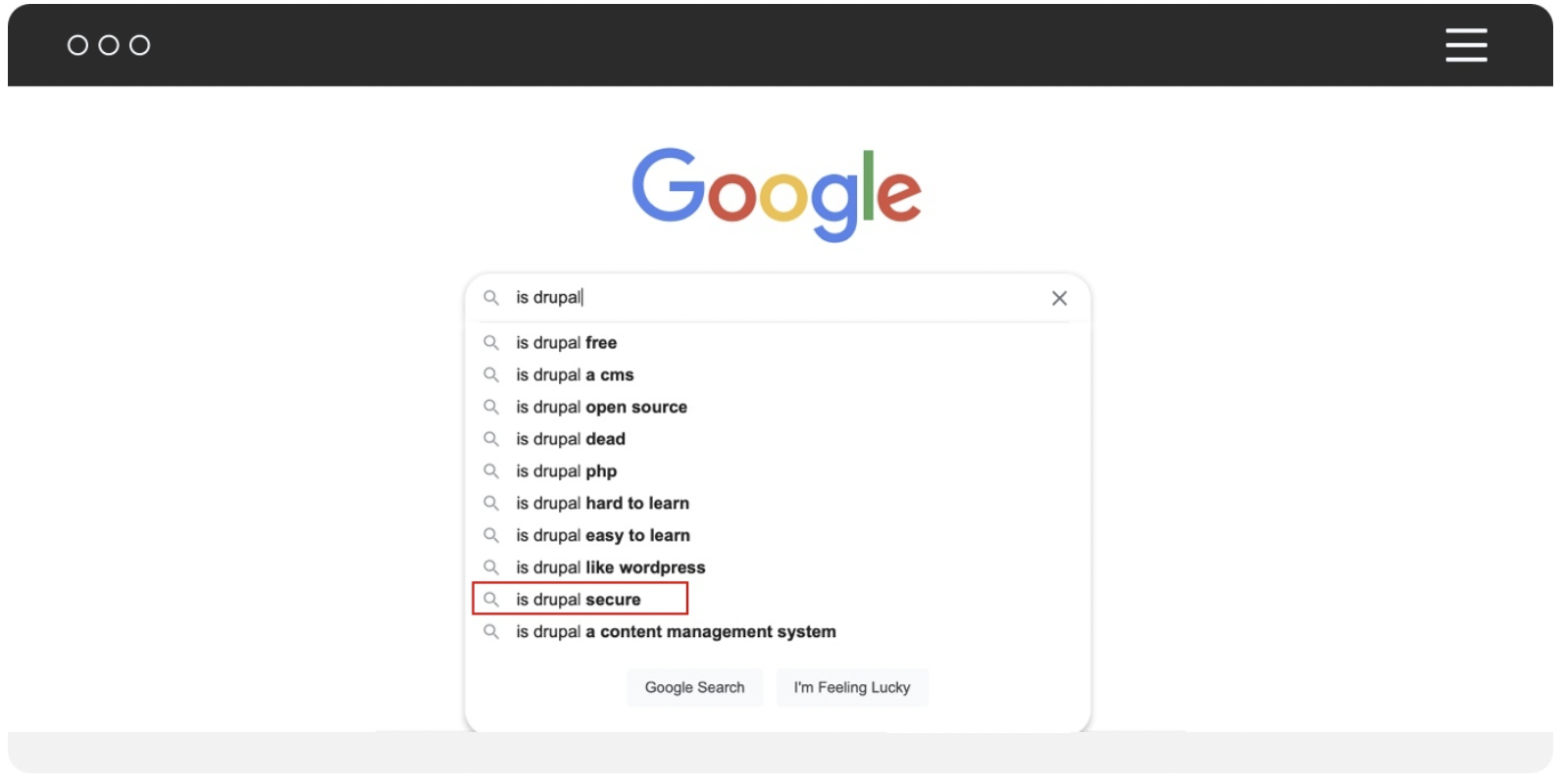
Drupal's security team is highly responsive and proactive, consistently monitoring vulnerabilities and issuing frequent security fixes for all actively maintained versions. The team follows a "coordinated disclosure policy," maintaining issue privacy until a fix is published. The Drupal Security Team's thoughtful communication ensures that users are well-informed and can take necessary actions.
“The Drupal Security Team follows a "coordinated disclosure policy": issues remain private until there is a published fix. A public announcement is made when the threat has been addressed and a secure version of Drupal core is also available. Even when a bug fix is made available, the Drupal Security Team is very thoughtful with its communication.”
- Dries Buytaert, Drupal Founder
Over the years, Drupal has demonstrated its resilience against critical security vulnerabilities, including those identified by OWASP in their top 10 security risks. The decrease in vulnerabilities from 2002 to 2021 attests to Drupal's commitment to providing a robust and secure education content management system. Frequent minor releases, especially after the introduction of Drupal 8 and 9, underscore Drupal's dedication to continuous innovation and the delivery of secure updates.
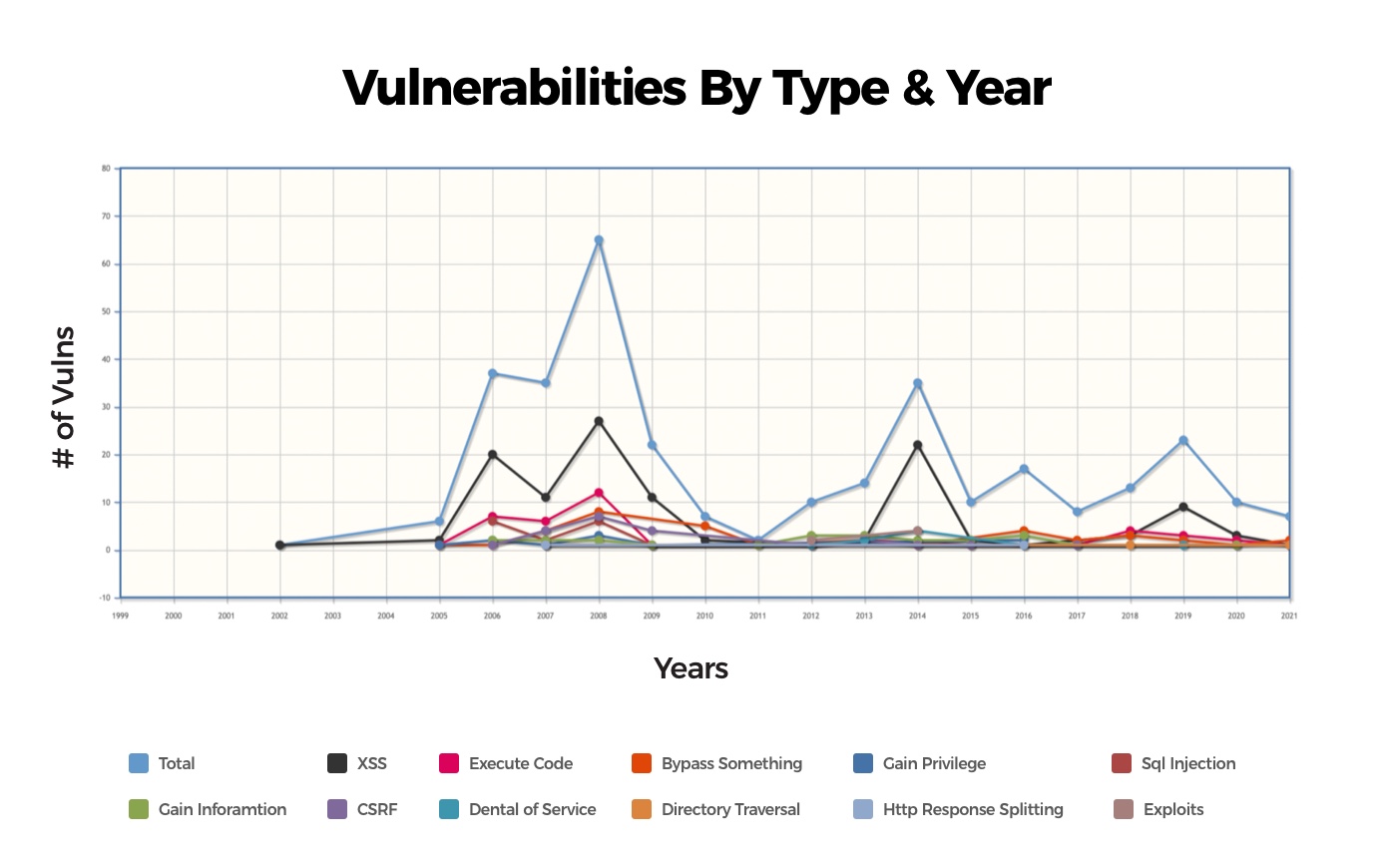
5. Multisite Architecture
In the landscape of higher education, where institutions manage diverse websites serving various functions, Drupal emerges as a robust solution for school content management systems (CMS). The built-in multisite functionality of Drupal provides universities and colleges with a versatile toolbox, empowering individual departments to communicate effectively with students, staff, and users through a unified system. This multisite capability not only allows for independence in managing websites but also significantly reduces administrative overhead for IT offices.
| Sr. No. | Factor | Consider Multisite | Don't Consider Multisite |
| 1 | The sites are for the same client and it is to simplify the scope of each site | ✓ | |
| 2 | The sites are similar in functionality, use the same modules or use the same Drupal distribution | ✓ | |
| 3 | You have limited resources/staffing, but lots of sites to manage and maintain | ✓ | |
| 4 | The functionality or scope are different | ✓ | |
| 5 | You are managing multiple distributions | ✓ | |
| 6 | The clients are different | ✓ |
An illustrative example of Drupal's multisite prowess is evident in OpenScholar, a research collaboration platform. OpenScholar's multi-tenant, robust, and modular architecture enables academic institutions to host thousands of websites within a single instance.
Axelerant's collaboration with OpenScholar involved implementing test automation systematically across the entire testing pyramid, contributing to quicker releases. Leveraging Organic Groups and Spaces modules, OpenScholar enables a single Drupal installation to host complete and discrete websites.
The platform supports custom domains, facilitating the seamless transfer of existing websites to OpenScholar, including the management of custom URLs within the site settings area of the control panel.
A Quick Tale
Delivering Seamless Digital Experience by Building Scalable Multisites for a Leading Research University
Axelerant's expertise shines in a case study involving a renowned public research university established in the mid-19th century. Facing scalability challenges with multiple websites built on PHP, the university sought Axelerant's assistance.
Read the case study to know how Axelerant leveraged its experience in CMS for higher ed to help the client deliver a world-class user experience, enabling them to build pages with ease.
6. Community Support
The success of the Drupal CMS platform is underlined by its extensive and devoted community. Key Drupal facts highlight the platform's widespread adoption and user satisfaction:
Some key Drupal facts:
-
Over 1.7 million websites use Drupal
- 7% of the top 10k websites use Drupal
- 97% of Drupal users are satisfied with it
- 46,603 Drupal modules can be downloaded for free
- In 2020, Drupal welcomed 8,000 individual contributors and over 1,200 corporate contributors
A pivotal aspect of Drupal's success is its vibrant and inclusive community. Drupalers, drawn to the platform for coding, find a community that becomes a family. Their commitment to strengthening and experience-driving the community is evident in their daily efforts.
“We believe that the Drupal project benefits from a diverse contribution pool, and we strive to foster a welcoming and inclusive culture everywhere Drupal exists — at events, online, and in our workplaces.”
- Drupal’s statement of values
Drupal is a common thread that weaves together Drupalers worldwide, without discrimination, with a single mission: the more you give, the more you get. And Drupalers happily volunteer their time in Drupal communities because it is fun, engaging, challenging, meaningful, and enjoyable.
At Axelerant, we eat, sleep, and breathe Drupal. We always look for different ways to give back to the Drupal community and prepare hard for Drupal events to leave a mark, learn from other Drupalers, implement the learnings, and come back prepared for the next engagement.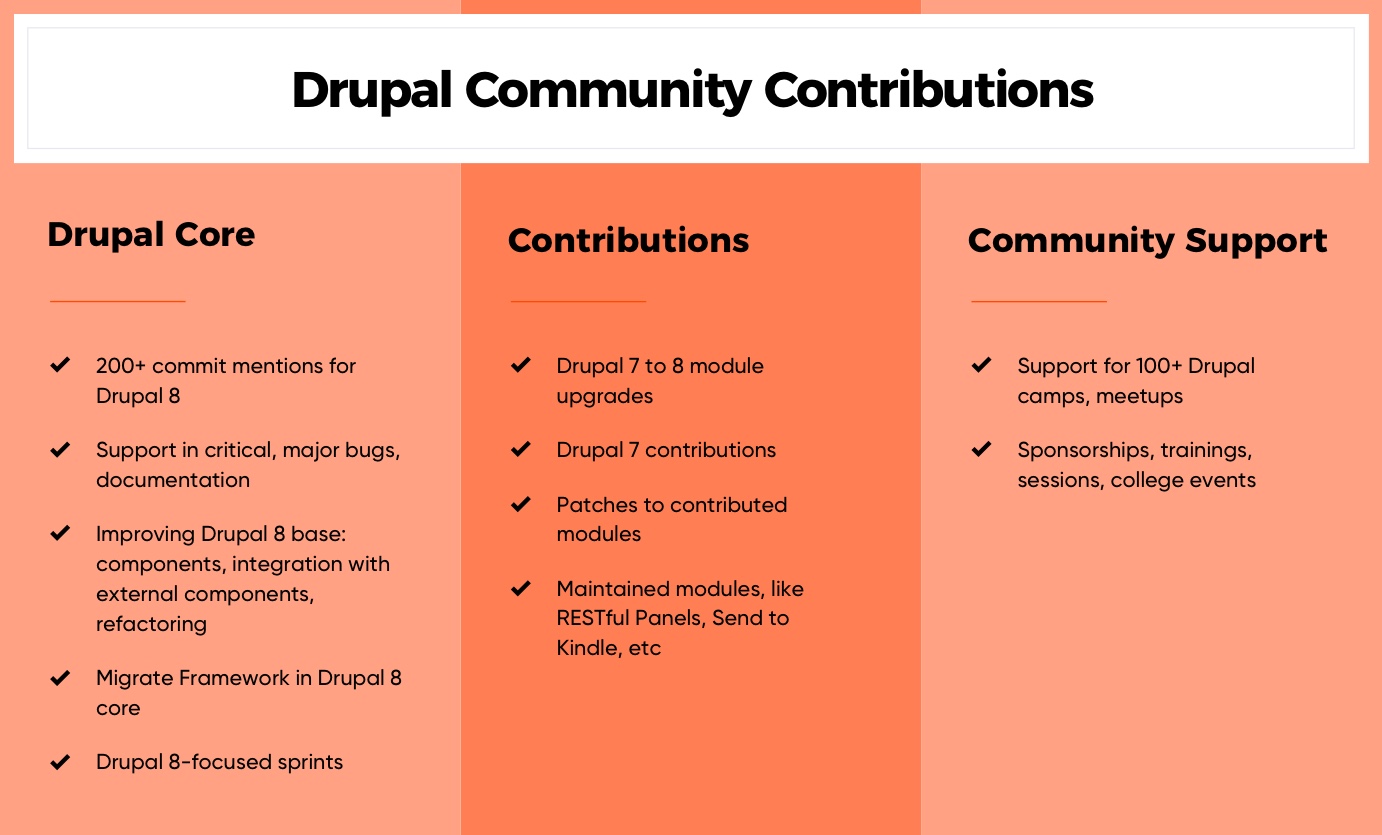
Even many university CIOs and academic I.T. leaders have evolved and opened up Higher Education by bringing Open Source projects to campus—at times subtly, sometimes hyperactively. This forwards the general mission of every university: to disseminate and expand knowledge and information across communities. Adopting Open Source software allows universities to put more into this mission.
Some community group examples are:
Wrap Your Website With An Experience-Driven Higher Ed CMS Platform: Drupal
In conclusion, Drupal's prowess in multisite architecture, coupled with its vibrant community support, positions it as a premier choice for higher education institutions seeking an experience-driven CMS platform.
In times of crisis, Drupal remains a steadfast partner, guiding the education industry through digital paradigm shifts while upholding the core mission of empowering informed citizens. Drupal's living, breathing digital platform ensures not just engagement but a seamless experience, contributing to its prevalence in over 70% of the top universities as their chosen education content management system.
Speak to the experts at Axelerant to learn more about Content Management System for Higher Education.

Prateek Jain, Director, Digital Experience Services
Offline, if he's not spending time with his daughter he's either on the field playing cricket or in a chair with a good book.
.jpg)
 We respect your privacy. Your information is safe.
We respect your privacy. Your information is safe.





Leave us a comment